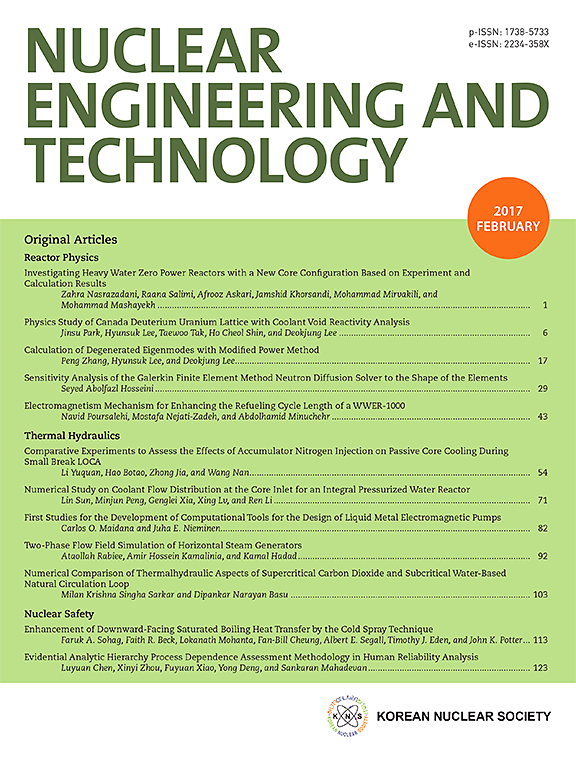利用原位物体计数系统(ISOCS)对放射性废物桶中的铀进行定量,以达到保障目的
IF 2.6
3区 工程技术
Q1 NUCLEAR SCIENCE & TECHNOLOGY
引用次数: 0
摘要
为和平利用核能、核材料和核技术,已开发出各种保障方法。其中,原位物体计数系统由于能够在没有标准材料的情况下运行,已在各种核材料核查活动中证明了其实用性和可靠性。在本研究中,利用韩国电力公司 NF 的一个实验桶以及韩国放射性废物管理局的低放射性废物桶,对原位物体计数系统在铀定量方面的性能进行了评估。结果表明,原位物体计数系统可以对放射性废物桶中的铀进行定量,与破坏性化验结果相比,相对误差在 -1% 到 -67% 之间。这项研究还使用蒙特卡洛 N 粒子传输 6.2 代码研究了影响铀定量不确定性的因素:几何条件、光谱质量、异质性和自屏蔽效应。这些研究结果可能有助于优化原位物体计数系统,使其成为保障监督背景下核材料核查的工具。本文章由计算机程序翻译,如有差异,请以英文原文为准。
Uranium quantification in radioactive waste drums using In-Situ Object Counting System (ISOCS) for safeguards purposes
For the peaceful use of nuclear energy, materials, and technology, various methods have been developed for safeguards purposes. Among them, the In-Situ Object Counting System has demonstrated its usefulness and reliability in various nuclear material verification activities, due to its capability of operating without standard materials. In the present study, the performance of In-Situ Object Counting System for uranium quantification was evaluated using an experimental drum at KEPCO NF as well as low-level radioactive waste drums at the Korea Radioactive Waste Agency. The results showed that In-Situ Object Counting System could quantify uranium in radioactive waste drums, with a relative error ranging from −1 to −67 % compared with destructive assay results. This study also examined, using the Monte Carlo N-particle transport 6.2 code, the factors that affect uncertainty in uranium quantification: geometrical conditions, spectrum quality, heterogeneity, and the self-shielding effect. These findings could prove useful in efforts to optimize the In-Situ Object Counting System as a tool for nuclear material verification in the safeguards context.
求助全文
通过发布文献求助,成功后即可免费获取论文全文。
去求助
来源期刊

Nuclear Engineering and Technology
工程技术-核科学技术
CiteScore
4.80
自引率
7.40%
发文量
431
审稿时长
3.5 months
期刊介绍:
Nuclear Engineering and Technology (NET), an international journal of the Korean Nuclear Society (KNS), publishes peer-reviewed papers on original research, ideas and developments in all areas of the field of nuclear science and technology. NET bimonthly publishes original articles, reviews, and technical notes. The journal is listed in the Science Citation Index Expanded (SCIE) of Thomson Reuters.
NET covers all fields for peaceful utilization of nuclear energy and radiation as follows:
1) Reactor Physics
2) Thermal Hydraulics
3) Nuclear Safety
4) Nuclear I&C
5) Nuclear Physics, Fusion, and Laser Technology
6) Nuclear Fuel Cycle and Radioactive Waste Management
7) Nuclear Fuel and Reactor Materials
8) Radiation Application
9) Radiation Protection
10) Nuclear Structural Analysis and Plant Management & Maintenance
11) Nuclear Policy, Economics, and Human Resource Development
 求助内容:
求助内容: 应助结果提醒方式:
应助结果提醒方式:


